If this email looks jacked up in your email window,
click on this link to see it on the website
https://arseniclullabies.com/nl20230831.html
Comedy writing is about discipline...here's some of mine
that didn't land and why
At Comic-Con International, a
question that came up continually was where the hell I've been
and why haven't I put out new A.L. I'll do that next time....I'm
just not in the mood, right now, for any unpleasant
introspection if it's all the same to you. But speaking of
talking to people at CCI, I was talking to friend of mine,
Jared Sams, who's got a comedy comic book out "Space
Negro...the last Negro
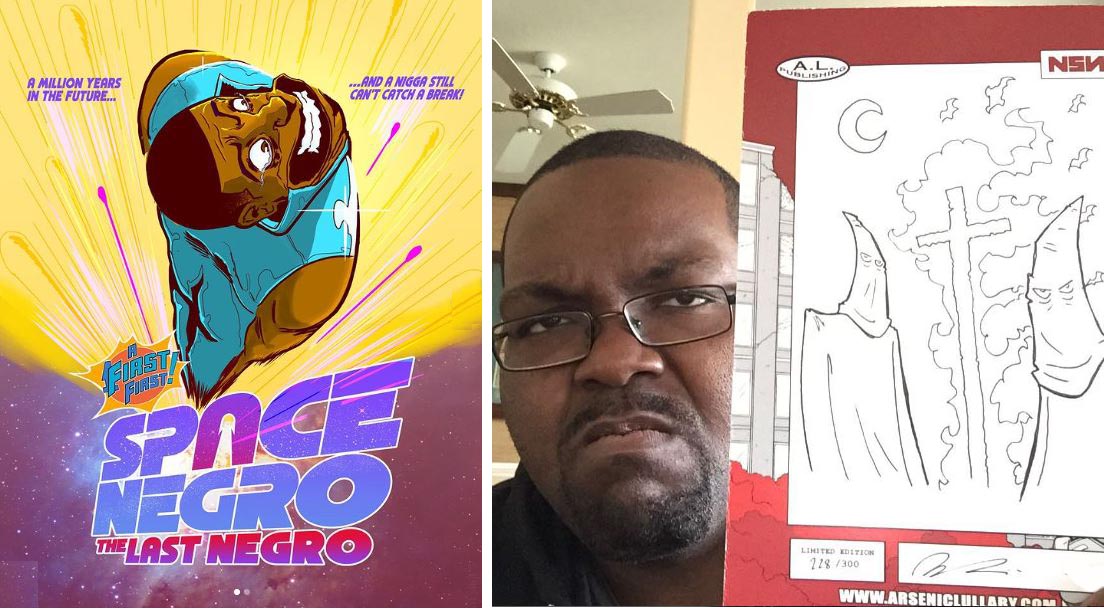
(link to his work
HERE).
I don't remember how,
exactly, I got onto to a tangent about writing comedy, but he
seemed to think it was an important tangent. So, I'll repeat it
here and break down some of my own failures.
What my point was that - the term "comedy" is given to way too
many things that aren't actually funny. They may be clever, well
done...they may be something we understand as funny, but they
don't actually produce laugher. They may produce a smile, we may
understand that it is comedic, we may appreciate for that....but
the gauge that needs to be used is this- if it makes you laugh
it is funny and if it doesn't make you laugh, it isn't funny. I
said "I don't think about how well I might be writing comedy, I'm
thinking about how to make people
laugh."
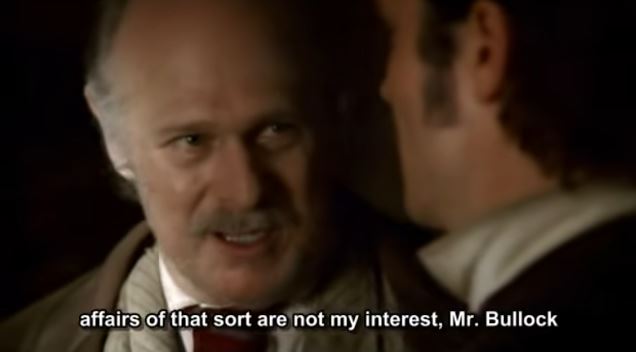

Whenever I am asked about writing comedy or asked for tips on
it, my first reply is this " Go to am open mic night at a comedy
club, where no one knows who you are and no ones gives a damn,
and find out the difference between clever and funny." Being on
stage and having some things work and some things fail gives you
a comedic compass that points true north, that you just can not get
any other way.
A quick example of what I mean by "funny" vs "comedic writing"
and then I'll get into the crafting of a joke to give it the
best chance to get a laugh. Ghostbusters and The Burbs, are in
my opinion, two of the most brilliant and ingenious comedy
movies ever made. Great premises, great casts, well executed, I
love them both. However, I can't say either one really made me
laugh that hard. Opposite of that would be "Observe and Report"
a forgotten Seth Rogan movie that no one in their right mind
would put in the same league as those other two. But Observe and
Report had a handful of scenes that made me laugh so hard I
could not stop. Ribs hurting, tears rolling down my face, the
whole nine yards.

And these were not cheap shock or gross out
jokes that you laugh at out accidentally, They were legit
lethally funny scenes. It is still an open question in my mind,
if the entire mediocrity of that movie overall was a calculated
backdrop to make those scenes as funny as they were...because
catching the audience flat footed is probably the most important
element to making them laugh. There's no way to ask him now,
because he died, but I'm almost positive Ray Liotta didn't know
he was in a comedy. He played every scene he was in so straight
that it just killed me. If the director somehow knew that's what
would work and left Ray in the dark as to just what kind of
movie he was in...that was genius.
With the understanding that the goal is making someone laugh, let's dive into some of what I do in A.L. to
get a laugh, and what I did wrong when it didn't work.
Let's start with some "types" of jokes. There is the standard -
set up-punch line type joke, like this one.
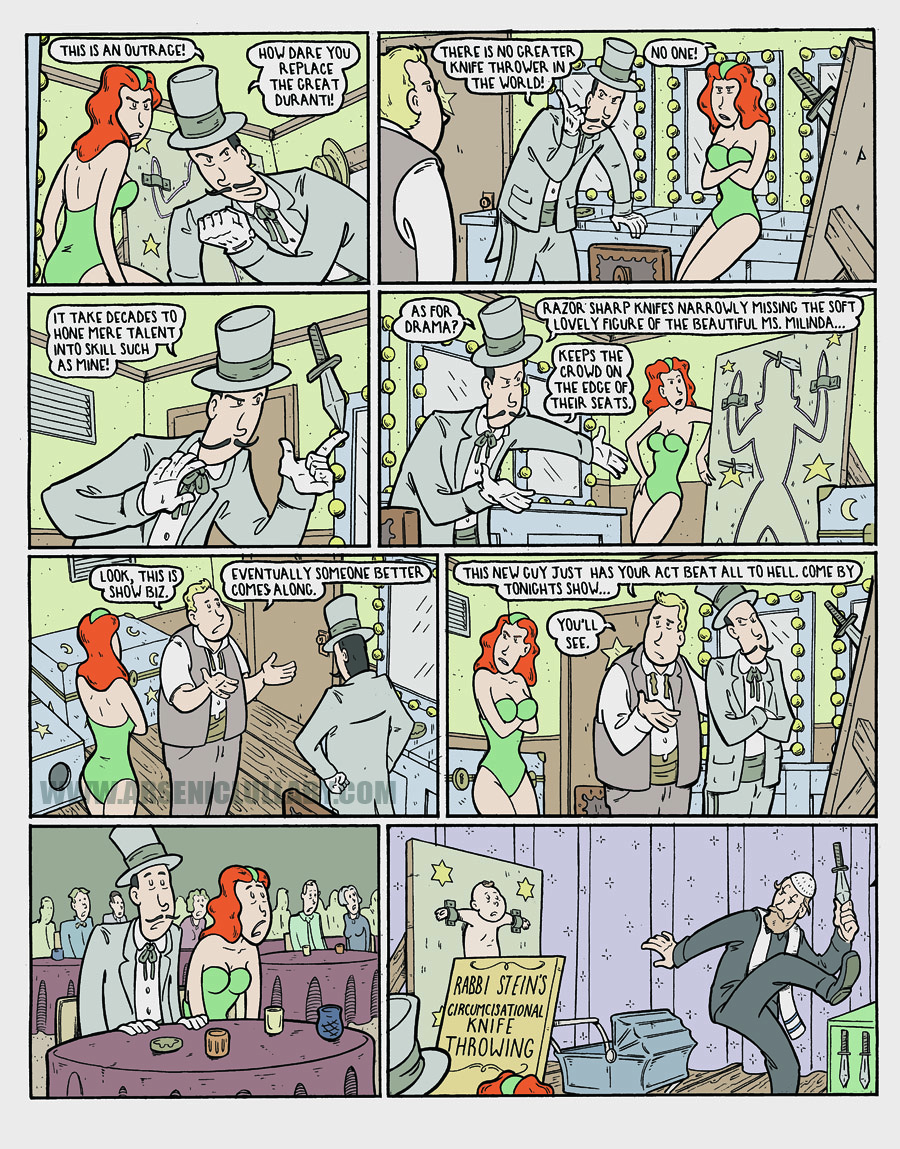
You got your set up- there's a knife throwing act that is far
better than someone else's, and your punch line - A Rabbi
throwing a knife to circumcise a baby. Essentially, the last
panel is the joke, but I load up the front end with things to
get the audience focusing on Duranti's ego, his indigence and
pride in his showmanship...directing the beginning of the story
down the road of - is this act actually better?- and keeping
that question grounded in a fairly normal world...then...pow.
Keeping in mind that it'll be funnier if people are accepting a
standard professional problem is going on, Duranti is in costume
and looking sharp, his gear is visible, he and his assistant
look like pros who take themselves seriously. The club owner too
looks legit, has the appearance of a guy busy trying to run a
club. I am careful to not go for any cheap gag here with how any
of them look or have anything weird or silly about Duranti's
equipment or props. It's all just a personality conflict between
a club owner and an entertainer until the end. Duranti is what I
call "rational collateral damage", Getting the
audience to accept and having their mindset beginning in the
lane of Duranti's rational, down to earth, plight is rather key
to the punching having a jolt.
It's a good premise aided by some
misdirection. There's comedic craftsmanship, but it does
breakdown to a pretty standard set up - punch line type joke.
I try to avoid those type of jokes when I can, and prefer jokes
like this.

Less a set up-punch line, than just a very dark/weird scene that
blindsides you. It lives or dies on premise, on how well you get
the audience to accept the premise and how well you make that
premise feel real. Crucial here is conveying his slow coming to
terms with what he heard and how hard it hits him. The eyes, the
slumped posture, the long drag off the cigarette all serve that
purpose. It's less a set up-punch line that you need to hit
correctly, than something that works by getting it
absorbed/accepted by the readers imagination.
I don't know if I'm just better at those or what, but they give
me less trouble. Usually when I have a good gag in my head and
don't quite nail it, it's a set up-punch line type joke.
I have a handful here that when I came up with them I was really
stoked...but...I didn't get them to really hit as well as they
could have...or in some cases just didn't work.
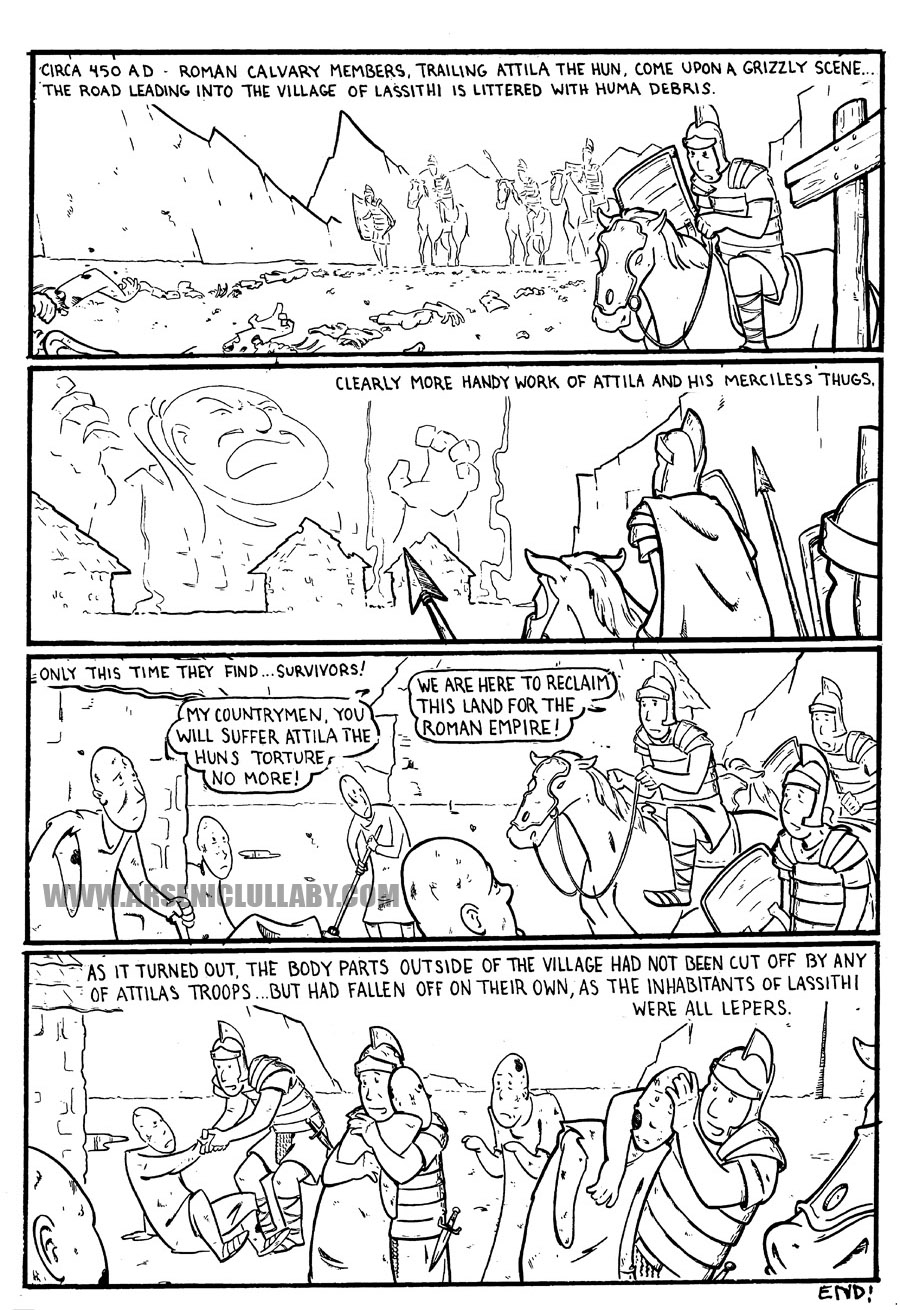
The gag here being that they see body parts laying around,
assume the people were chopped up by Huns but really the parts
fell off because of leprosy. There is some over explaining going
on here on the back end. The reveal might have been better as
just a warning sign that the solders don't notice.
Also, we have "two jokes on a joke" here, which is a cardinal
sin if you want an actual laugh. Whatever funny would be from
the reveal, is going at the same time whatever funny would be
from the solders hugging the lepers. I think maybe the sign, and
then them hugging would have been a better way to go. Maybe a
panel more focused on the horror the solders feel upon seeing
the body parts and thinking it was from people being cut up.
Yeah...the solders horror, then jubilation that there's
survivors, then the sign, then hugging. Even then it might not
have landed...it could just be a premise that's too esoteric.
Let's look at one that did work for a second so I can explain
something...
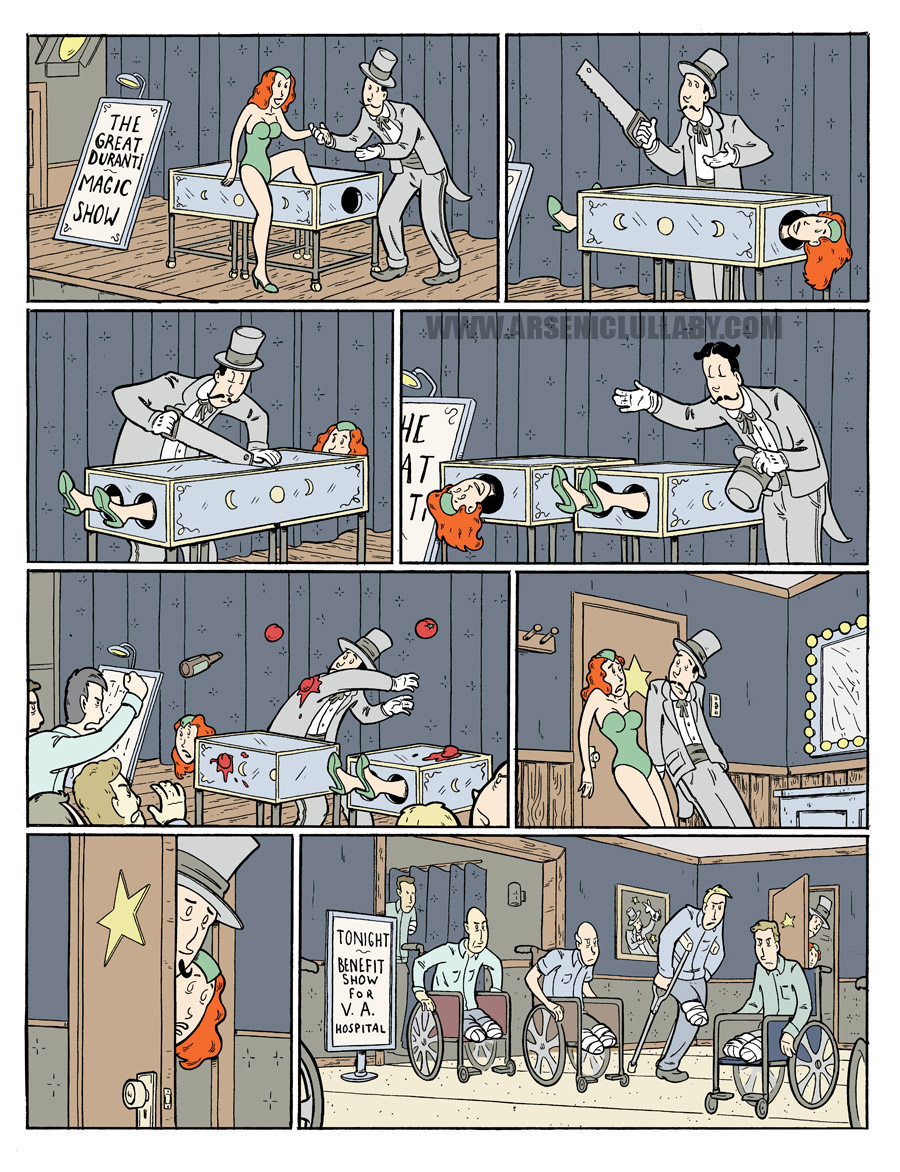
Nice clean punch line. Now IF, for some reason I decided to make
the amputees look silly or tried to get some comedic mileage out
of how they look or by hinting at how they lost their legs
specifically, that would have been -two jokes on a joke. Instead
of the clean punch of the audience all having had legs
amputated, it would have been two concepts competing for
recognition at the same time. It might have been appreciated,
but it would not have produced a laugh.
Here's a quote about what produces a laugh, that
might help...
"our brain is suddenly jolted into accepting the unacceptable.
The punch line of a joke is the part that conflicts with the
first part, thereby surprising us and throwing our synapses into
some kind of fire drill"
Gary Larson
To that end, two jokes on a joke is no good, they just end up
diminishing the reaction to each other.
Or, more succinctly
"You never do two jokes on a joke"
Richard Lewis
This next failure vexes me to this day. Because it is a
brilliantly dark premise that should have been a 9 out of 10,
but I forgot my training. My training comes not from any comic
book pro past, present, or future, or trails and errors in comic
books at all. It comes from years doing of stand up comedy. You
are on stage, alone, and you get laughs or every second feels
like an eternity. Thus you never get stage time or learn real
fast the difference between "clever" and "making people laugh"
and how to streamline what's not needed and enhance what is. So
here's the subpar execution...

What neuters what could have been one of my greatest pages ever
was, once again, over explaining and also being too smart by
half. The gag is more simple than I made it- Terrorists from
overseas grab guy to behead, with the thought that it will be
more horrific than anything Americans are used to on their own
soil...and the head get's stolen by a headless horseman, who'd
been doing this for centuries. That they think this is horror
that the U.S. has never seen is all that needs to be gotten
across with their dialogue. That could have been done in three
or four panels, with a panel of the head getting chopped, maybe
a panel of how satisfied he is with his horrific act. Instead I
had it drone on for 8 panels. AND, I was so concerned with a
reader inadvertently seeing the headless horseman at the end and
ruining it for themselves, that I drew him small and
inconspicuous in the last panel. That is always a concern, the
reader spoiling it for themselves...but in this case, in trying
to prevent that, I sacrificed any comedic impact of seeing the
headless horseman.
We also have a bit of two jokes on a joke again. That the
horseman, who is a story told to children for 200 years,
juxtaposed with the terrorist's who consider themselves the apex
of scary, committing the same act, is gag, but
the terrorists, who consider themselves the apex of scary. getting their head stolen is also
somewhat of a gag by
itself. Maybe a panel of terrorist lamenting that "he stole our
head" after the reveal of the horseman? Perhaps a "give me
that!" instead of the "yoink" would have been the way to go.
"Give me that" being more serious and less silly...then him
saying "thanks for the head, jerks!" would have gelled better
with the reveal? I don't know...but I made this too complicated
to really land as well as it should have.
It is EXTREMELY important to understand what is the point of the
gag...what elements are needed to guide the audience and
WHAT...EXACTLY...is funny about it. Every time a gag goes astray
it is because I forgot to keep that in mind, and when a gag
works, it's because I did keep it in mind.
Here's a gag that works, even though I am technically doing a
lot of things wrong...but they are wrong in service of getting
the laugh...

This is heavy on the dialogue on the front end, to heavy for
most cases, and it is putting the readers mind into a state
where they are no doubt arguing against one side or the
other...which is also something I try to avoid. In most cases,
once the reader is up in their brains in a political argument,
they are going to miss any joy that a punch line might deliver,
because they ARE off in their own heads. But in this specific
case, that is just where I want them to be. I want them every
bit as myopically focusing on their own view of the issue as the
guy and the doctor. so that they to are completely blindsided by
what is actually going on. To that end, they are both making
points that could be argued against and neither is coming across
as a nut or overly insightful. They are both rolling out
opinions we've all heard before and no doubt have an answer to
being brought to our minds when we see the alien burst out.
The second thing I did here that is usually a handicap is being
a bit too close to -two jokes on a joke. The reveal of it having
been a xenomorph and the dad xenomorph being pissed, are pretty
damn close timing wise. But it is such a left turn out of the
argument to a sci fi juxtaposition that the final punch being
the Xenomorph Dad hits just right and the child reaching up is
noticed only after any laugh the reveal of the dad produces.
Sometimes, I think, a premise is just doomed to not be able to
be mined properly. This next one...I think it's dark and
ingenious, but it just doesn't hit. Years later I still honestly
don' know what could be done...
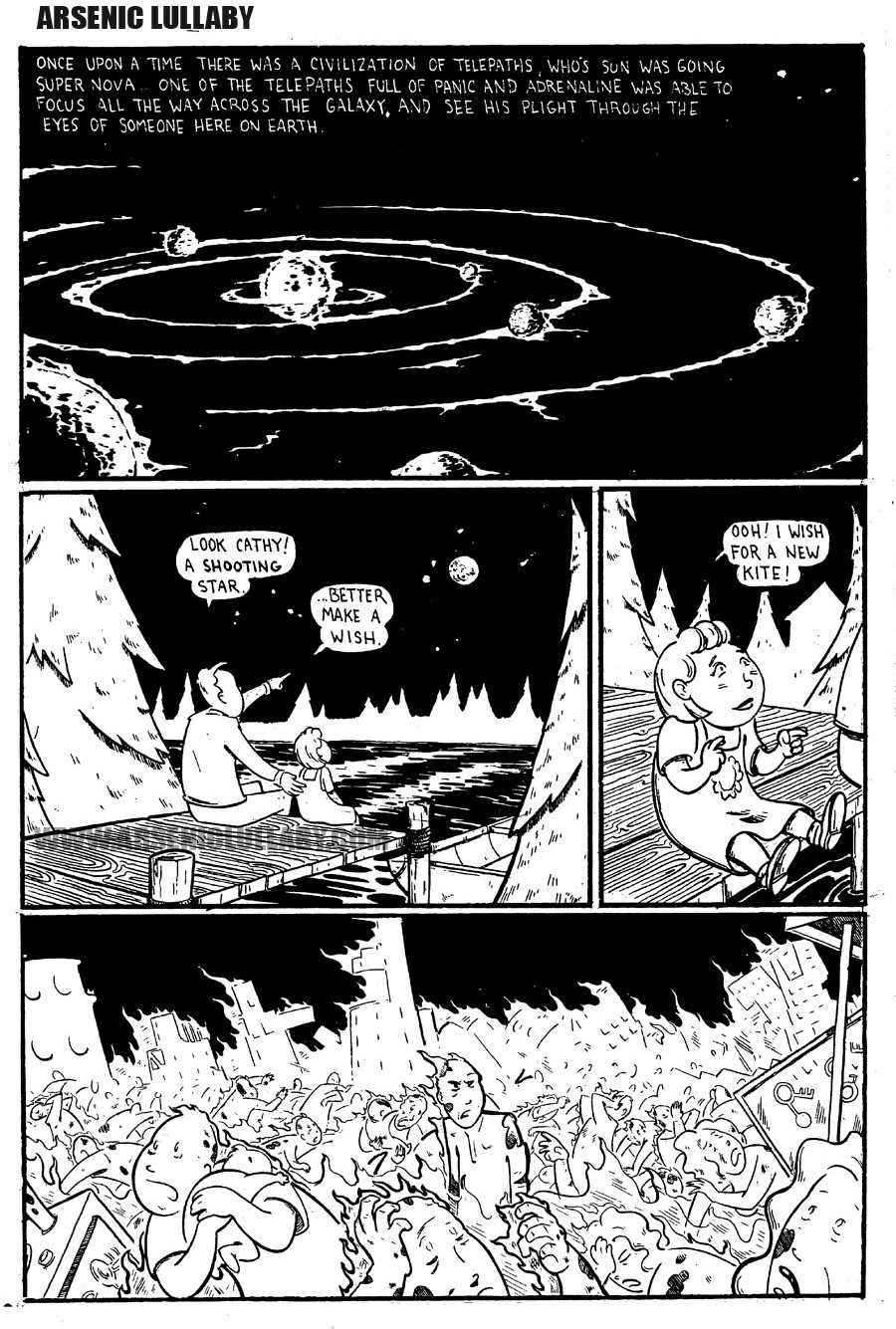
That last panel is what came to me first, and the concept of
some guy who's world is coming to a horrific end becoming aware
that some kid in another galaxy somewhere is just using the
event to wish
for a toy, is funny. But how does he become aware of that, how
do I get that across? I still don't know. Probably an instance
of a premise that's just always going to over extend itself.
Here's another one that has a similar problem. In my head the
last part was funny but getting there was murky and maybe just
not visceral enough to be worth the path to get to it.

Starting with "what is the point of the gag", what about this
one I thought I could get a laugh with- To me it was that the
guy got screwed by a giant alien bug and they are just both
going to pretend that didn't happen. Even now I'm not certain
exactly about that would have worked best to focus on. Should it
be funny in a extension of the unspoken guy code being taken to
an extreme? Funny that he got screwed by a giant alien bug
because he didn't know crickets scratch their legs as a mating
call? In that regard...there could be plenty of readers who
don't know that. So. what I got here is a less than lethal
presentation of both. I think this one was just kinda doomed to
be so-so at best, and I probably should have just passed on it
but that last panel, which was what first can to my mind, sure
seemed like I could get something great out of.
For the sake of my own ego, I'll end with one that works and is
technically sound on every level. Good premise, well executed
set up/punch line but is also just a weird and funny scene, and
if someone glances first at the last panel, it will be confusing
instead of being a spoiler.

A well executed premise there, if I do say so myself. Comedy and
horror are not far off in the techniques and tool box that they
use. Timing, what information you present and how, odd camera
angles...they can punch up a joke just as well as give a good
scare. A little extra insight into hiding the punch line with
this one...the box/stars are the same color as the puddle of
blood/fetus, to keep that from standing out visually. If the box
was blue with yellow stars the puddle and fetus might be easily
noticed on first glance at the page.
As long as I'm thinking about it and I don't know when it'll
come up again, and even though it very specific to comic book
comedy, lemme school you on some visual geography of the page.
This I know from many years and, by this point, hundreds of
thousands of people looking at my comics in person at
comic-cons.

Know that and accept it. If you're trying to hide something, keep
it out of there, if you are looking to make sure they see
it...sticking it in any of those sections is one way of doing
that. Having said that, as there are several dozen other things
to worry about in laying out a comic book page...sometimes you
just have to pick the lesser of two evils and put things where
you put things. I this case, I did a decent enough job at keeping
spoilery stuff out of those zones.
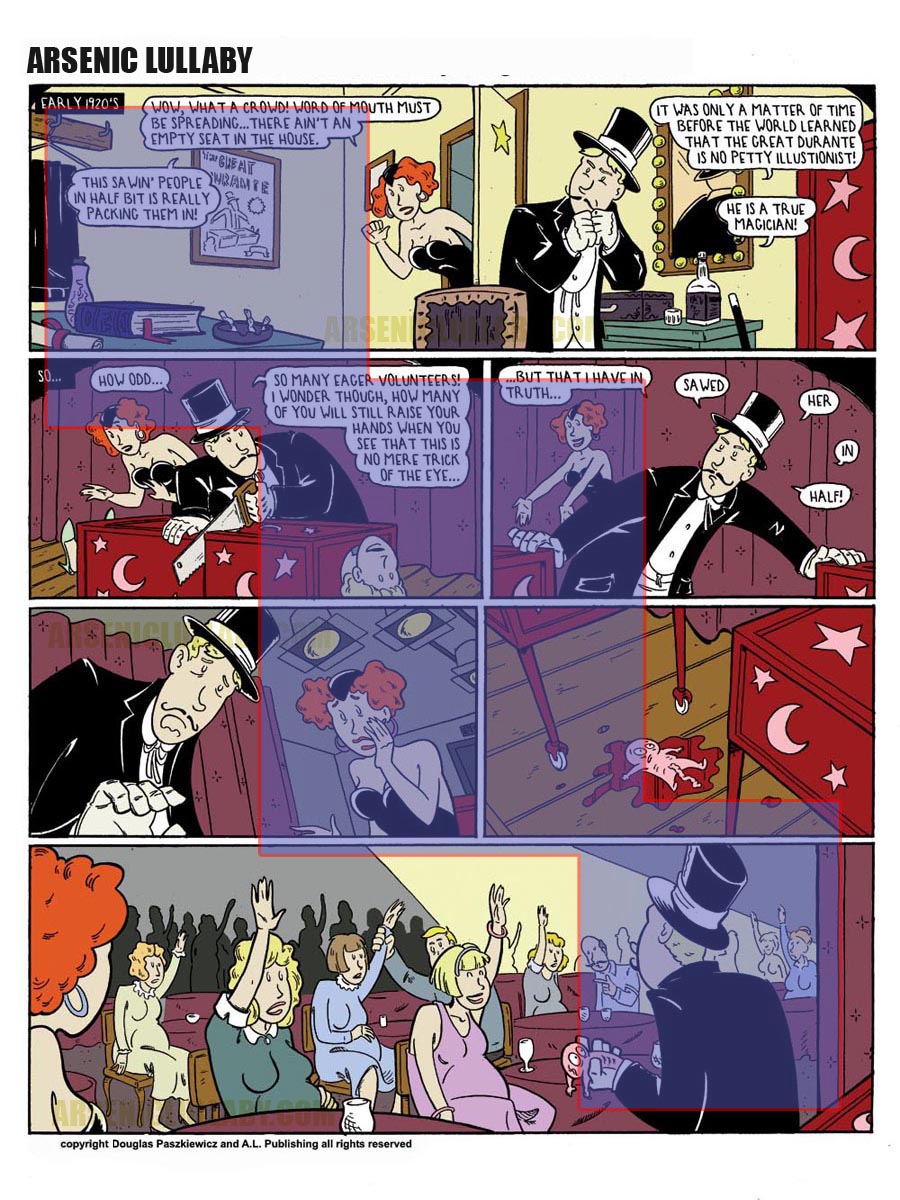
Anyways...never do two jokes on a joke. Always make sure you are
keeping in mind what is supposed to get the laugh and why and
how best to aid that. There's more to it all, but it's not
exactly in my best interest to tell you everything I know.
Oh...and most importantly, go to a comedy
club, or nothing I've told you will do much good. It doesn't
matter how well I explain navigation if you don't have a compass
that points true north. You want to know how to make people
laugh, go try to people laugh. People who don't know or gaf
about you.
"dying is easy, comedy is hard"
Later